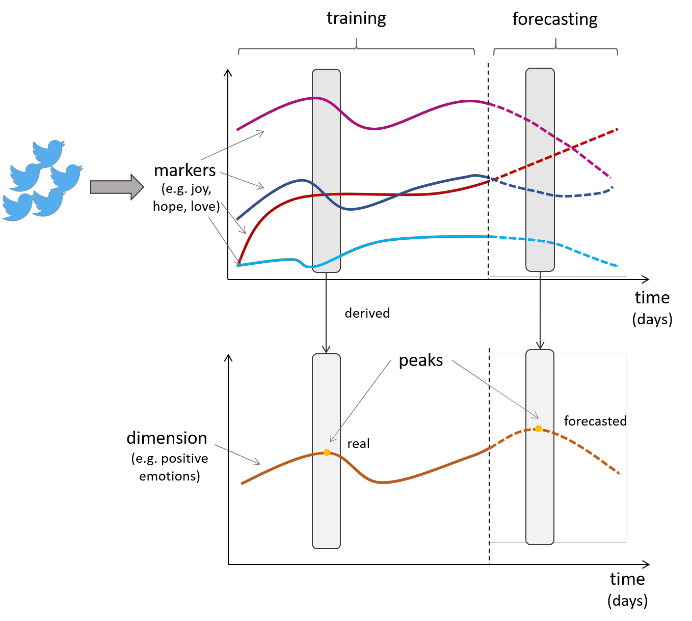Purpose. We present an approach for forecasting mental health conditions and emotions of a given population during the COVID-19 pandemic based on language expressions used in social media. This approach permits anticipating high prevalence periods in short- to medium-term time horizons. Design. Mental health conditions and emotions are captured via markers, which link social media contents with lexicons. First, we build descriptive timelines for decision makers to monitor the evolution of markers, and their correlation with crisis events. Second, we model the timelines as time series, and support their forecasting, which in turn serve to identify high prevalence points for the estimated markers. Findings. Results showed that different time series forecasting strategies offer different capabilities. In the best scenario, the emergence of high prevalence periods of emotions and mental health disorders can be satisfactorily predicted with a neural network strategy, even when limited data is available in early stages of a crisis (e.g., 7 days). Originality. Although there have been efforts in the literature to predict mental states of individuals, the analysis of mental health at the collective level has received scarce attention. We take a step forward by proposing a forecasting approach for analyzing the mental health of a given population (or group of individuals) at a larger scale. Practical implications. We believe that this work contributes to a better understanding of how psychological processes related to crisis manifest in social media, being a valuable asset for the design, implementation and monitoring of health prevention and communication policies.
翻译:目的:我们根据社交媒体使用的语言表达方式,提出在COVID-19大流行期间预测特定人群心理健康状况和情绪的方法;这一方法可以预测短期至中期时间范围内的高流行率时期;设计;通过标志捕捉心理健康状况和情绪,将社交媒体内容与词汇系统联系起来。第一,我们为决策者制定描述性时间表,以监测标记的演变及其与危机事件的相关性。第二,我们把时间序列作为时间序列,并支持其预测,这反过来有助于为估计标记确定高流行率点。调查结果显示,不同的时间序列预测战略提供不同的能力。在最佳情况下,情绪和心理健康失调高流行率时期的出现可以通过神经网络战略得到令人满意的预测,即使危机早期阶段(例如,7天)有有限的数据可用。原始情况。尽管在文献中作出了预测个人心理状态的努力,但在集体一级对心理健康的分析却很少受到注意。我们向前迈出了一步,提出了一种预测方法,用以分析心理健康、情绪和心理健康失调的流行期,从而使人们更深刻地了解与人口有关的实际健康影响。



































